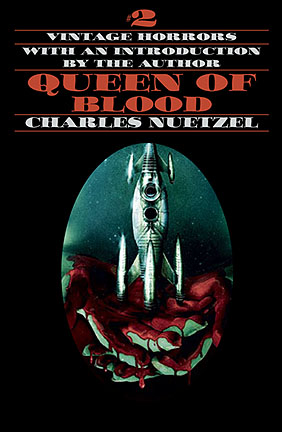 By CHARLES NUETZEL (Centipede Press; 1966/2015)
By CHARLES NUETZEL (Centipede Press; 1966/2015)
The second entry in Centipede Press’ “Vintage Horrors” series, and not nearly as strong as the first, Ed Wood’s ORGY OF THE DEAD. Yet QUEEN OF BLOOD deserves credit for being as readable as it is, given that it was cobbled together in an extremely short timeframe—so claims author Charles Nuetzel in a newly written introduction that, in keeping with the nature of the material, feels quite hasty and thrown-together in its own right.
The flick was an American International Pictures low budgeter that was admittedly conceived around footage filched from a couple of Soviet sci fi epics by writer-director Curtis Harrington. What resulted was a choppy and confusing mess with one or two mildly haunting scenes to its credit. The film, with its combination of scares and space opera, is most interesting these days for the way it foreshadows ALIEN—although it had in fact already been bested in the proto-ALIEN category by Mario Bava’s PLANET OF THE VAMPIRES, which I’d recommend viewing in place of QUEEN OF BLOOD.
But onto the novelization under discussion, which fully reflects the shortcomings of its source material. The setting is the “future” year 1990, when an extraterrestrial radio transmission is picked up. It promises a visit by an alien emissary, but first an unrelated mechanical device is sent to Earth. The device turns out to be a video recording of the alien ship crash landing on Mars. In a most unwise decision, a band of astronauts are dispatched on a rescue mission to the red planet (interplanetary travel being a mundane reality in this novel’s 1990).
On Mars a comatose green skinned woman, identified as Queen Velana, is discovered aboard the crashed alien spacecraft. Once ensconced among the astronauts the Queen comes to life, revealing herself as a space vampire who can hypnotize men—but only men, thus leaving the lone woman astronaut with a definite edge—in which state she drinks their blood.
Nuetzel adds far more technical jargon than was present in the film, giving the novel’s early sections a somewhat MARTIAN-esque feel. He also intensifies the material’s sexual angle in sentences like “Her space suit, unlike that of Earth astronauts, was skin-tight, accentuating the bulge of brimming breasts that heaved with her every breath” (fact: this novel was initially classified as an adults-only publication). Unfortunately enough, the romantic angle that was only suggested in the film has also been beefed up, to none-too-agreeable effect. What Nuetzel fails to add is much in the way of excitement, which is something this largely inert account could have definitely used.
